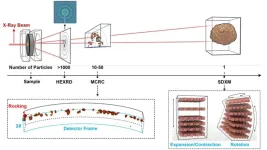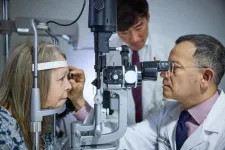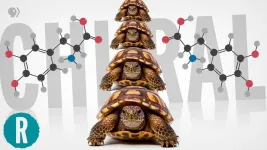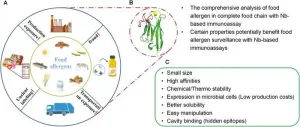(Press-News.org) The first generation of lithium-ion batteries for electric vehicles has been a remarkable success story. Yet, the question arises: What changes to battery materials will spur further advances to extend driving range and lower costs?
A better positive electrode, or cathode, for lithium-ion batteries has been the focus of intense past research. The cathode is one of the main components in batteries. Several candidates for cathode materials offer the prospect of batteries with much higher energy storage, leading to longer driving range. However, the capacity, or amount of current flowing out within a given time, tends to decline rapidly with charge-discharge cycling for reasons unknown.
“Our method should also be useful to understanding failure mechanisms in other battery types than present-day lithium-ion.” — Tongchao Liu, assistant chemist
Researchers at the U.S. Department of Energy’s (DOE) Argonne National Laboratory have discovered the main reason why and how one of the more promising cathode materials degrades with use. That material is a lithium nickel manganese cobalt (NMC) oxide rich in nickel and in the form of single nanosized crystals. In single crystals, all the atoms are arranged in the same highly ordered pattern.
“Nickel-rich NMC is especially appealing because it uses 70-80% nickel, a high-capacity material, and requires much less cobalt,” said Assistant Chemist Tongchao Liu. Cobalt is expensive and considered a critical mineral because of supply issues.
Typically, the nickel-rich NMC cathode consists of particles of multiple crystalline forms, or polycrystals, randomly oriented with respect to each other. With charge-discharge cycling, however, these clusters crack at the boundaries among the crystals, and the cathode capacity rapidly drops.
It had been hypothesized that fabricating the cathode with single crystals instead of polycrystals would solve the cracking problem, as the boundaries would be eliminated. However, even single-crystal cathodes failed prematurely, leaving scientists perplexed.
To uncover the mechanism, the team devised a pioneering method that combines multiscale X-ray diffraction and high-resolution electron microscopy. These materials analyses were done at the Advanced Photon Source (APS) at Argonne, the National Synchrotron Light Source at DOE’s Brookhaven National Laboratory and Argonne’s Center for Nanoscale Materials (CNM). All three are DOE Office of Science user facilities.
“The problem with electron microscopy alone is that it only provides a snapshot of a small area on a single crystal,” said Materials Scientist Tao Zhou in CNM. “And while X-ray diffraction offers insights into internal structures of many particles, it lacks surface-level information. Our method bridges this gap, offering a comprehensive understanding at the scale of one, 10 to 50, and 1,000 particles.”
The atoms in single crystals are arranged in neatly ordered rows and columns called lattices. The team’s multifaceted analyses of single-crystal cathodes provided crucial information about changes in the lattice on charge and discharge.
As Liu and Zhou explained, introduction of a charge triggers a strain on the lattice that causes it to expand and rotate, disrupting the neatly ordered pattern of atoms. Upon discharge, the lattice contracts to its original state, but the rotation remains. With repeated charge-discharge cycles, the rotation becomes more pronounced. This change in the cathode structure causes a steep performance drop.
Critical to gaining these insights were measurements with the Hard X-ray Nanoprobe operated jointly by CNM and APS.
“The team’s new method was instrumental in understanding the burning issue of why nickel-rich NMC cathodes with single crystals fail so rapidly,” said Khalil Amine, an Argonne Distinguished Fellow. “This newfound understanding will give us ammunition to fix this issue and enable lower-cost electric vehicles with longer driving range.”
“Our method should also be useful to understanding failure mechanisms in other battery types than present-day lithium-ion,” added Liu.
This research appeared in Science. In addition to Liu, Zhou and Amine, authors include Weiyuan Huang, Lei Yu, Jing Wang, Junxiang Liu, Tianyi Li, Rachid Amine, Xianghui Xiao, Mingyuan Ge, Lu Ma, Steven N. Ehrlich, Martin V. Holt and Jianguo Wen.
This work was supported by support by the DOE Office of Energy Efficiency and Renewable Energy, Vehicle Technologies Office.
About Argonne’s Center for Nanoscale Materials
The Center for Nanoscale Materials is one of the five DOE Nanoscale Science Research Centers, premier national user facilities for interdisciplinary research at the nanoscale supported by the DOE Office of Science. Together the NSRCs comprise a suite of complementary facilities that provide researchers with state-of-the-art capabilities to fabricate, process, characterize and model nanoscale materials, and constitute the largest infrastructure investment of the National Nanotechnology Initiative. The NSRCs are located at DOE’s Argonne, Brookhaven, Lawrence Berkeley, Oak Ridge, Sandia and Los Alamos National Laboratories. For more information about the DOE NSRCs, please visit https://science.osti.gov/User-Facilities/User-Facilities-at-a-Glance.
About the Advanced Photon Source
The U. S. Department of Energy Office of Science’s Advanced Photon Source (APS) at Argonne National Laboratory is one of the world’s most productive X-ray light source facilities. The APS provides high-brightness X-ray beams to a diverse community of researchers in materials science, chemistry, condensed matter physics, the life and environmental sciences, and applied research. These X-rays are ideally suited for explorations of materials and biological structures; elemental distribution; chemical, magnetic, electronic states; and a wide range of technologically important engineering systems from batteries to fuel injector sprays, all of which are the foundations of our nation’s economic, technological, and physical well-being. Each year, more than 5,000 researchers use the APS to produce over 2,000 publications detailing impactful discoveries, and solve more vital biological protein structures than users of any other X-ray light source research facility. APS scientists and engineers innovate technology that is at the heart of advancing accelerator and light-source operations. This includes the insertion devices that produce extreme-brightness X-rays prized by researchers, lenses that focus the X-rays down to a few nanometers, instrumentation that maximizes the way the X-rays interact with samples being studied, and software that gathers and manages the massive quantity of data resulting from discovery research at the APS.
This research used resources of the Advanced Photon Source, a U.S. DOE Office of Science User Facility operated for the DOE Office of Science by Argonne National Laboratory under Contract No. DE-AC02-06CH11357.
Argonne National Laboratory seeks solutions to pressing national problems in science and technology by conducting leading-edge basic and applied research in virtually every scientific discipline. Argonne is managed by UChicago Argonne, LLC for the U.S. Department of Energy’s Office of Science.
The U.S. Department of Energy’s Office of Science is the single largest supporter of basic research in the physical sciences in the United States and is working to address some of the most pressing challenges of our time. For more information, visit https://energy.gov/science.
END
Unlocking the mystery behind the performance decline in a promising cathode material
Insights could help foster electric vehicle batteries with longer driving range and lower cost
2024-06-17
ELSE PRESS RELEASES FROM THIS DATE:
A call for renaming clinical research partnerships
2024-06-17
PHILADELPHIA (June 17, 2024) - In a recently published opinion piece in BMJ Open, “Rhetoric of Research: A Call for Renaming the Clinical Research Partnership,” authors from Penn Nursing and Georgetown University School of Nursing, present a compelling argument for rethinking the language used to describe participants in clinical research. The opinion calls for a shift from the traditional term “patient participant” to “participant partner,” emphasizing the crucial role of participants in ...
SwRI breaks ground on new hypersonic engine research facility
2024-06-17
SAN ANTONIO — June 17, 2024 —Southwest Research Institute (SwRI) today celebrated the groundbreaking of the Center for Accelerating Materials and Processes (CAMP), a new facility that will support research and development for tomorrow’s high-speed aerospace engines.
“This project will help ensure the U.S. is a leader in high-speed propulsion research and development,” said Dr. Barron Bichon, director of SwRI’s Materials Engineering Department. “SwRI is committed to advancing this vital technology on behalf of Texas and the nation.”
Market forces including growth in global defense, air travel, ...
International Gemini Observatory and Subaru combine forces to discover first ever pair of merging quasars at cosmic dawn
2024-06-17
Since the very first instant after the Big Bang the Universe has been expanding. This means that the early Universe was considerably smaller and early-formed galaxies were more likely to interact and merge. Galaxy mergers fuel the formation of quasars — extremely luminous galactic cores where gas and dust falling into a central supermassive black hole emit enormous amounts of light. So when looking back at the early Universe astronomers would expect to find numerous pairs of quasars in close proximity to each other as their host galaxies undergo mergers. However, they have been surprised ...
Repurposed drug may help stabilize vision in rare disease
2024-06-17
Roughly 50 families scattered across the world share ultra-rare variants in a particular gene. Silent for years, the inherited mutations make themselves known when patients reach the fourth decade of life. Changes in vision start a cascade of symptoms. Five to 20 years later, the illness is fatal.
Researchers at Washington University School of Medicine in St. Louis have dedicated many years to understanding the rare condition known as retinal vasculopathy with cerebral leukoencephalopathy and systemic manifestations, or RVCL-S, with the aim of developing a treatment ...
Face screening tool detects stroke in seconds
2024-06-17
A new smartphone face-screening tool could help paramedics to identify stroke in seconds – much sooner and more accurately than is possible with current technologies.
Strokes, which affect millions of people globally, occur when the blood supply to part of the brain is interrupted or reduced, which prevent brain tissue from getting oxygen and nutrients. A few minutes of delay can result in permanent damage to the brain cells.
A team of biomedical engineers at RMIT University developed the AI capabilities behind the software technology and has published their results ...
Making this Parkinson's drug is just turtles all the way down (video)
2024-06-17
WASHINGTON, June 17, 2024 — L-DOPA is the best drug we have for Parkinson’s disease, but its molecular mirror image, D-DOPA, causes dangerous side effects. Making L-DOPA without also making D-DOPA is surprisingly hard and requires a specific kind of molecule to pull off. But that specific molecule must be made from a different and equally specific molecule. In this video, our host, George Zaidan, explains how one of the winners of the 2001 Nobel Prize in Chemistry pulled it off, and why "chiral synthesis," as it's called, is really just turtles all the way down. https://youtu.be/_cb09XB07LQ?si=BuMEI5fOuHmuQlkZ
Reactions is a video series ...
Camelid nanobodies: Transforming food allergen analysis
2024-06-17
Recent advancements show nanobodies from camelid antibodies excel in food allergen detection with superior stability, specificity, and cost-effectiveness. This innovative approach aims to improve accuracy and efficiency, crucial for preventing severe allergic reactions. The study highlights nanobodies' potential in reliable immunoassays, addressing rising food allergies and enhancing safety measures.
Food allergies pose significant health risks, affecting millions worldwide, with the prevalence rising over the past decades. Traditional detection methods, such as monoclonal and polyclonal antibodies, are often costly, labor-intensive, and prone to cross-reactions. The need for ...
Federal study examines care following nonfatal overdose among Medicare beneficiaries; identifies effective interventions and gaps in care
2024-06-17
Researchers from the Substance Abuse and Mental Health Services Administration (SAMHSA), the National Institutes of Health’s (NIH) National Institute on Drug Abuse (NIDA), Centers for Medicare & Medicaid Services (CMS), and the Centers for Disease Control and Prevention (CDC) found that among a cohort of 137,000 Medicare beneficiaries who experienced a nonfatal overdose in 2020, almost 24,000 (17.4%) experienced a subsequent nonfatal overdose, and about 1,300 (1%) died from overdose in the following year. Results were published today in JAMA Internal Medicine, identifying both effective interventions and significant gaps in care.
“People who have experienced ...
Maternal inheritance of Alzheimer’s disease tied to increased risk of developing disease
2024-06-17
KEY TAKEAWAYS
Mass General Brigham researchers analyzed 4,400 cognitively unimpaired adults with amyloid imaging, finding increased amyloid in those who reported that their mothers had symptoms of Alzheimer’s disease (AD).
Increased amyloid, a biomarker of AD, was also found in those with a history of the disease on both sides of their family and in those whose fathers had an early onset of symptoms.
The study suggests that a person’s maternal versus paternal family history could ...
Epidemiologic features of recovery from SARS-CoV-2 infection
2024-06-17
About The Study: More than 1 in 5 adults did not recover within 3 months of SARS-CoV-2 infection in this cohort study. Recovery within 3 months was less likely in women and those with preexisting cardiovascular disease and more likely in those with COVID-19 vaccination or infection during the Omicron variant wave.
Corresponding Author: To contact the corresponding author, Elizabeth C. Oelsner, M.D., M.P.H., email eco7@cumc.columbia.edu.
To access the embargoed study: Visit our For The Media website at this link https://media.jamanetwork.com/
(doi:10.1001/jamanetworkopen.2024.17440)
Editor’s Note: Please see the article for additional information, ...
LAST 30 PRESS RELEASES:
Making lighter work of calculating fluid and heat flow
Normalizing blood sugar can halve heart attack risk
Lowering blood sugar cuts heart attack risk in people with prediabetes
Study links genetic variants to risk of blinding eye disease in premature infants
Non-opioid ‘pain sponge’ therapy halts cartilage degeneration and relieves chronic pain
AI can pick up cultural values by mimicking how kids learn
China’s ecological redlines offer fast track to 30 x 30 global conservation goal
Invisible indoor threats: emerging household contaminants and their growing risks to human health
Adding antibody treatment to chemo boosts outcomes for children with rare cancer
Germline pathogenic variants among women without a history of breast cancer
Tanning beds triple melanoma risk, potentially causing broad DNA damage
Unique bond identified as key to viral infection speed
Indoor tanning makes youthful skin much older on a genetic level
Mouse model sheds new light on the causes and potential solutions to human GI problems linked to muscular dystrophy
The Journal of Nuclear Medicine ahead-of-print tip sheet: December 12, 2025
Smarter tools for peering into the microscopic world
Applications open for funding to conduct research in the Kinsey Institute archives
Global measure underestimates the severity of food insecurity
Child survivors of critical illness are missing out on timely follow up care
Risk-based vs annual breast cancer screening / the WISDOM randomized clinical trial
University of Toronto launches Electric Vehicle Innovation Ontario to accelerate advanced EV technologies and build Canada’s innovation advantage
Early relapse predicts poor outcomes in aggressive blood cancer
American College of Lifestyle Medicine applauds two CMS models aligned with lifestyle medicine practice and reimbursement
Clinical trial finds cannabis use not a barrier to quitting nicotine vaping
Supplemental nutrition assistance program policies and food insecurity
Switching immune cells to “night mode” could limit damage after a heart attack, study suggests
URI-based Global RIghts Project report spotlights continued troubling trends in worldwide inhumane treatment
Neutrophils are less aggressive at night, explaining why nighttime heart attacks cause less damage than daytime events
Menopausal hormone therapy may not pose breast cancer risk for women with BRCA mutations
Mobile health tool may improve quality of life for adolescent and young adult breast cancer survivors
[Press-News.org] Unlocking the mystery behind the performance decline in a promising cathode materialInsights could help foster electric vehicle batteries with longer driving range and lower cost








